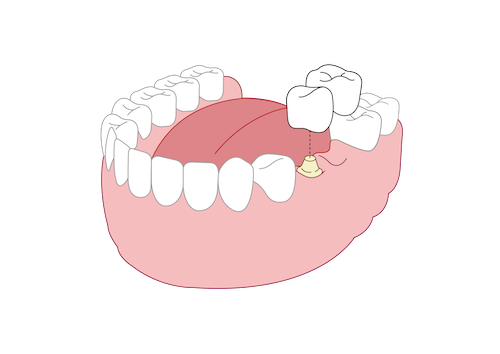4
Keep smiling with a conventional fixed partial denture (bridge)
A fixed partial denture (FPD), also known as a bridge, is used to replace missing teeth. An artificial tooth on a FPD is permanently attached to adjacent teeth. It is like a ‘bridge’ and the natural teeth act as ‘pillars’ to support it.
Conventional fixed partial dentures have one or more artificial teeth and are held in place by natural teeth on either one or both sides; the natural teeth are prepared and capped with crowns and attached to the replacement tooth or teeth.
Image
 |
When/why should you choose this option?
- One or more missing teeth needs to be replaced in a certain location.
- You would like a fixed replacement for your missing teeth as opposed to a removable option.
- It can be used to replace teeth at the front (incisors and canines) or back of the mouth (premolars and molars).
- You have enough strong teeth with good bone support for the artificial teeth to connect to; your dentist will call these abutments or abutment teeth. Otherwise, the FPD will be at risk of becoming loose after a while.
- A major advantage is that it can provide a natural-appearing result with less bulk and more comfort than a removable option.
What do you need to be aware of?
- The natural supporting teeth or abutments will need to be cut and filed into shape.
- A cantilever design may help preserve more of your natural teeth because they are only fixed to one side. This design can be used to replace a single tooth if the supporting tooth is sound.
- When an abutment tooth is prepared for a crown, there is the risk of causing injury to its nerves and blood vessels, or it can become damaged over time. When this happens, the abutment tooth may need root canal treatment; therefore, the bridge may be damaged in the process. A root canal treated abutment may become a weak tooth, especially as an abutment for another new bridge, with the risk of root fracture in the future.
- It can be more difficult to keep the FPD plaque free, putting the restored abutment teeth at greater risk of caries and gum disease. Extra care to clean the bridge is necessary to avoid this. The tooth-coloured material on the bridge may chip.
- Natural teeth change colour with age, which can make them look different from the bridge over time.
What will you need to do to improve your chance of long-term success?
- Good oral hygiene is essential to help prevent problems. Brush your teeth twice a day with a toothpaste containing at least 1,100 ppm fluoride if your risk of dental caries is low.
- You also have to clean under the false tooth every day and between your teeth. This will be more difficult around the FPD as the artificial tooth is fixed to the teeth next to it. Ask your dentist about special flossing or brushing tools to make it easier.
- Eat a well-balanced diet that is low in sugar.
- Your dentist will assess your risk and need for periodic review. This might be between 3-12 months depending on his/her recommendation.
What if there are problems?
- There may be different solutions available, according to your individual situation and problem. For example:
- if you develop caries and gum disease, your dentist may remove the caries around the FPD and work with you to improve your oral hygiene;
- if you lose an abutment tooth, the FPD will fail; it may, however, be possible to replace it with a new one;
- if there are fractures to the tooth-coloured surface, your dentist may be able to repair it;
- if there is a mismatch in colour between your natural and restored teeth, whitening the natural teeth may be the easiest solution if your natural teeth respond to whitening.
- You and your dentist can agree on the best plan of care for you.
What other factors do we need to consider?
- Invasiveness of procedure: It is invasive. The supporting natural teeth are cut and shaped to prepare them for the crowns, which means some of the original, healthy tooth structure is removed.
- Treatment fees: The cost will vary depending on the size and type of FPD.
How does this option affect you?
Conventional FPDs have proven to provide a stable, reliable, and functional means of restoring missing teeth when it is performed properly. They look and feel natural which may benefit your quality of life.